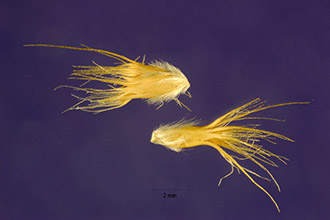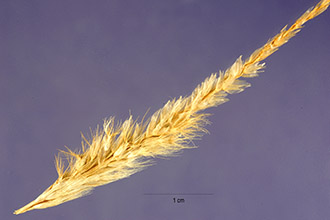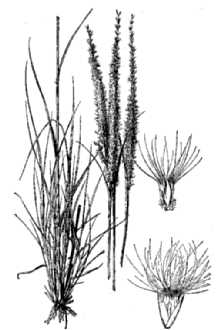Whiplash Pappusgrass
Scientific Name: Pappophorum vaginatum Buckley

| General Information | |
|---|---|
| Usda Symbol | PAVA2 |
| Group | Monocot |
| Life Cycle | Perennial |
| Growth Habits | Graminoid |
| Native Locations | PAVA2 |
Plant Guide
Description
General: Whiplash pappusgrass is a native, warm-season, perennial bunch grass with a height of 2 to 3.5 feet. The leaf blade is flat, narrow, up to 10 inches long, and with edges that may roll inward. The seed head is 4 to 8 inches long, narrow, tightly contracted, with a whitish or tawny appearance only rarely with a slight purple tinge (Gould, 1975). Distribution: Please consult the Plant Profile page for this species on the PLANTS website for current distribution. It is found in Texas, New Mexico, and Arizona. Habitat: Whiplash pappusgrass is found in dry rangelands of Texas to Arizona with annual rainfall of 10 to 20 inches. In the west it occurs at elevations of 2,500 to 4,000 feet. It is associated with Arizona cottontop, false Rhodes grass, alkali sacaton, plains bristle grass, and vine mesquite.
Adaptation
Whiplash pappusgrass grows well on most soil types including sandy loam, clay, clay loam, and saline clay soils.
Uses
Whiplash pappusgrass is useful for upland wildlife plantings, highway right-of-way, and ecosystem restoration. It provides fair forage for livestock.
Status
Please consult the PLANTS website and your State Department of Natural Resources for this plant’s current status (e.g. threatened or endangered species, state noxious status and wetland indicator values).
Planting Guidelines
Begin seedbed preparation in advance of the planting. Establish a clean, firm, weed-free seedbed by tillage or herbicides. Allow the site to accumulate soil moisture prior to planting. Schedule plantings for early spring when moisture is more abundant and before warm season weeds begin growing. Whiplash pappusgrass is best seeded using a native-grass drill equipped with picker wheels to ensure even flow and distribution of whiplash pappusgrass fluffy seed over the planting area. Broadcast seeding may be used in areas not easily planted with a drill, but some type of additional coverage such as culti-packing or light dragging to ensure good seed to soil contact. Seed coatings (talc based) can also be used to increase the flowability of the fluffy seed through standard seed drills. Plant seed ⅛ to ¼ inch deep. It is better to plant too shallow than too deep. For calibration purposes, Webb Germplasm whiplash pappusgrass contains approximately 436,250 uncoated seeds per bulk pound. The recommended seeding rate is 3 PLS lb/acre. Permian Germplasm contains approximately 338,501 uncoated seed/lb with a seeding rate of 2-3 pounds pure live seed PLS lb/acre. When planting seed mixtures, reduce the seeding rate according to the desired percentage of whiplash pappusgrass in the mixture. Use soil test recommendations to correct soil fertility deficiencies prior to planting. Avoid applying nitrogen fertilizer until a stand is evident. A successful planting consists of 1 to 2 plants per square foot. Natural Resources Conservation Service Plant Guide Forrest Smith, South Texas Natives
Management
Avoid grazing whiplash pappusgrass the first year, Use soil moisture sensors to measure the soil moisture of Whiplash Pappusgrass., Use grazing management to maintain long-term sustainable production, Contact your local NRCS field office for assistance in developing a prescribed grazing plan, Whiplash pappusgrass is a long-lived perennial that benefits from maturing seed every 2 to 3 years to encourage recruitment and stand health from volunteer seedings,
Pests and Potential Problems
Common pests of whiplash pappusgrass seed include fall armyworms (Spodoptera spp.), thrips (Thrips spp.), and rice stink bugs (Oebalus pugnax). Control of pests may be necessary to produce seed crops in dry years under irrigation.
Environmental Concerns
Concerns
Concerns
There are no environmental concerns with whiplash pappusgrass.
Control
Please contact your local agriculture extension agent or extension weed specialist to learn what herbicides work best for weed control in your area and how to use it safely. Always read label and safety instructions for each control method.
Seeds and Plant Production
Plant Production
Plant Production
Whiplash pappusgrass seed production fields can be established from greenhouse grown transplants or drilled on bedded or flat rows. Seedlings grow and mature quickly, producing a marketable seed crop the first year. Seed is harvested with a Flail Vac (Ag Renewal Inc., Weatherford, OK) or similar brush-type harvester. The use of slow travel and RPM speeds while harvesting results in relatively clean seed. Debearding the seed can be accomplished with a brush machine; however, aggressively debearding can remove the caryopsis from the glumes and may damage the seed. A clipper seed cleaner (A.T. Ferrell Company, Inc., Bluffton, IN) has been used to remove stems and chaff following debearding processes. Seed yields average 50 bulk lb/acre. Seed purity is usually around 54% and germination rates about 47%. Adequately stored seed in humidity and temperature-controlled facilities can be viable for 5 to 10 years. Cultivars, Improved, and Selected Materials (and area of origin) Webb Germplasm whiplash pappusgrass is a blend of 3 collections from the Rio Grande Plains of Texas and released by Texas A&M-Kingsville South Texas Natives, the USDA-NRCS E. “Kika” de la Garza Plant Materials Center, and Texas AgriLife Research Station in Beeville, Texas (2010). It was selected for its good seed germination, seed viability, and seedling vigor. It is predominantly adapted to sandy loam, claypan prairie, and saline clay range sites in south Texas. Breeder seed is maintained by South Texas Natives in conjunction with Texas Foundation Seed Service. Permian Germplasm whiplash pappusgrass is a blend of 4 collections from Texas and released in 2020 by Texas A&M-Kingsville Texas Native Seeds and the USDA-NRCS James E. “Bud” Smith Plant Materials Center. It was selected for upland wildlife habitat improvement, critical area revegetation, highway and energy transport right-of-way, energy exploration and development reclamation, and rangeland plantings for west Texas. Breeder seed is maintained by Texas Native Seeds in conjunction with Texas Foundation Seed Service. Pima Germplasm whiplash pappusgrass is a blend of 16 collections from Arizona and released in 2006 by the USDA-NRCS Tucson Plant Materials Center. It was selected for release for ecosystem restoration, erosion control, wildlife cover, and restoration of disturbed areas in southern Arizona. Breeder seed is maintained by USDA-NRCS Tucson Plant Materials Center (Garner, Hershdorfer, and Munda, 2006).
Literature Cited
Garner, E.R., M.E. Hershdorfer, and B. Munda. 2006. Notice of Release of Pima Pappusgrass Selected Class of Germplasm. USDA-NRCS Tucson Plant Materials Center. Tucson, Arizona. Gould, F.W. 1975. The Grasses of Texas. Texas A&M University Press. College Station, Texas. Citation Lloyd-Reilley, J. 2010. Plant Guide for whiplash pappusgrass (Pappophorum vaginatum Buckley). USDA-Natural Resources Conservation Service, E. “Kika” de la Garza Plant Materials Center. Kingsville, Texas, 78363. Published: October, 2010 Edited: 14Sep2010 sdm; 03Feb2020 cbc; 10Mar2020 jld For more information about this and other plants, please contact your local NRCS field office or Conservation District at http://www.nrcs.usda.gov/ and visit the PLANTS Web site at http://plants.usda.gov/ or the Plant Materials Program web site: http://plant-materials.nrcs.usda.gov. PLANTS is not responsible for the content or availability of other Web sites. In accordance with Federal civil rights law and U.S. Department of Agriculture (USDA) civil rights regulations and policies, the USDA, its Agencies, offices, and employees, and institutions participating in or administering USDA programs are prohibited from discriminating based on race, color, national origin, religion, sex, gender identity (including gender expression), sexual orientation, disability, age, marital status, family/parental status, income derived from a public assistance program, political beliefs, or reprisal or retaliation for prior civil rights activity, in any program or activity conducted or funded by USDA (not all bases apply to all programs). Remedies and complaint filing deadlines vary by program or incident. Persons with disabilities who require alternative means of communication for program information (e.g., Braille, large print, audiotape, American Sign Language, etc.) should contact the responsible Agency or USDA's TARGET Center at (202) 720-2600 (voice and TTY) or contact USDA through the Federal Relay Service at (800) 877-8339. Additionally, program information may be made available in languages other than English. To file a program discrimination complaint, complete the USDA Program Discrimination Complaint Form, AD-3027, found online at How to File a Program Discrimination Complaint and at any USDA office or write a letter addressed to USDA and provide in the letter all of the information requested in the form. To request a copy of the complaint form, call (866) 632-9992. Submit your completed form or letter to USDA by: (1) mail: U.S. Department of Agriculture, Office of the Assistant Secretary for Civil Rights, 1400 Independence Avenue, SW, Washington, D.C. 20250-9410; (2) fax: (202) 690-7442; or (3) email: program.intake@usda.gov. USDA is an equal opportunity provider, employer, and lender.


